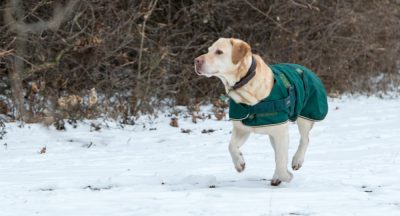Put Pet Cold Weather Myths in the Deep-Freeze

Pets' reactions to cold weather vary widely.
Some pets love cold weather and are eager to get outside to romp and play in the fluffy, white snow. Other pets feel the bitter cold air's rush as you open the door, and hightail it back to their warm, cozy bed. No matter your pet's outdoor temperature preferences, our team wants to help you keep your furry friend safe and warm this winter. Learn the truth about pet cold safety myths, and protect your pet from the elements this winter.
Cold weather myth #1: A pet's fur keeps them warm in extremely cold temperatures
TRUTH: When the temperature plummets, some people believe their pet's thick fur coat helps them tolerate the extreme cold. However, without proper garments or shelter, your pet's fur coat is no match for long periods of cold exposure. Pets' cold tolerance varies depending on the following factors:
- Coat - Northern and mountain dog breeds who have thick undercoats tend to do best when temperatures plummet. These include Siberian huskies, Samoyeds, Alaskan malamutes, Great Pyrenees, Icelandic sheepdogs, Newfoundlands, and others. However, even if your dog has a thick undercoat, they need to acclimate to low temperatures, and are at risk for cold weather dangers when temperatures drop below zero.
- Size - Smaller dogs have a greater surface-area-to-weight ratio, which causes them to lose heat more quickly than larger dogs.
- Age - Young pets and seniors cannot regulate their body temperature as well as adult pets in their prime.
- Health If your pet has a chronic health condition, such as diabetes, kidney failure, Cushing's disease, or hypothyroidism, they may be more cold-averse than healthy pets.
Thick-coated pets are not usually affected by cold temperatures until they fall below 45 degrees. However, pets who are cold-averse may become uncomfortable in temperatures higher than 45 degrees. When temperatures drop below freezing-32 degrees-every pet becomes susceptible to cold weather-related problems.
Myth #2: Cold weather does not affect a pet's paws
TRUTH: Cold weather can be hard on your pet's paws. Snow and ice can increase your pet's frostbite risk, and dry out their paw pads, leaving their skin chapped or cracked. Snow and ice balls can get stuck between their toe pads, irritating the skin, and deicing sidewalk salt can cause chemical burns. To protect your furry friend's precious paws during winter weather, follow these tips:
- Pet boots -Like human boots, pet boots can protect your furry pal's paw pads by minimizing contact with harsh salt and chemicals, and preventing snow, ice, salt, and other debris from lodging between their toes.
- Paw balm -If your pet refuses to wear boots when they must be out during winter weather, always check their paw pads for irritation, cracks, bleeding, or accumulated snow and ice when they come back indoors. In addition, thoroughly wash and dry your pet's paws after exposure to ice melt, and use petroleum jelly or paw balm to moisturize and protect the pads.
Myth #3: Pets don't need parasite prevention during the cold months
TRUTH: A common misconception is that parasites disappear when the temperatures drop, but fleas, ticks, and heartworms are a year-round threat. Most parasites don't die, but rather overwinter when temperatures drop, so they still pose a threat to your pet's health. The Companion Animal Parasite Council (CAPC) recommends year-round parasite prevention for all pets, as well as routine parasite-related disease testing. Ask our veterinary team to recommend the best prevention product for your pet.
Myth #4: Pets are less likely to get lost during the winter
TRUTH: Pets can become lost any time, and winter's snow and ice suppress recognizable scents that may have helped them find their way home. Microchip your pet to help ensure their safe return, and keep their registration up-to-date in the microchip registry. In addition to microchipping, always ensure your pet wears a well-fitting collar with current identification tags.
MYTH #5: Your unattended pet is safe in a vehicle when outdoor temperature are low
TRUTH: You likely know that hot vehicles are dangerous for unattended pets, but cold temperatures can be equally dangerous. With little insulation, your vehicle is similar to a refrigerator, and temperatures inside can quickly drop. When you must run errands, the best place for your pet is safe and warm at home.
After learning the truth about some common cold weather myths and pet safety, ensure your pet stays cozy and warm. Remember, preventive care is important throughout the year. Contact our team to schedule your pet's wellness exam.

